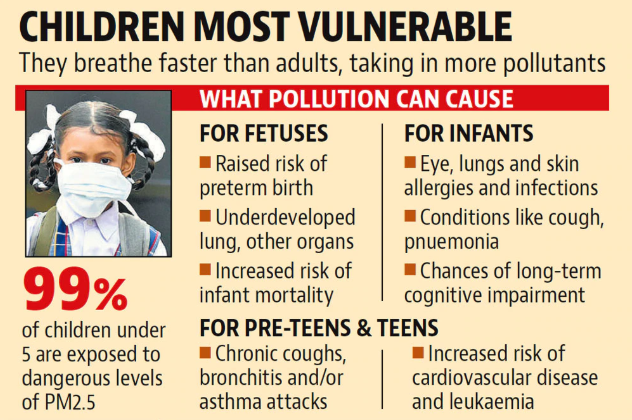Air Pollution & Concerted Efforts
This article is based on “Poor air quality is a danger to public health” which was published in The Hindustan Times on 23/10/2020. It talks about the issue of Air pollution and the need for concerted efforts to deal with it.
Recently, the State of Global Air 2020 report was released. The report has highlighted two warnings for India. Firstly, India recorded the highest annual average PM 2.5 concentration exposure in the world in 2019. Secondly, the country has had the worst levels of PM 2.5 levels in the world for the last decade.
Despite many efforts taken by the government to tackle air pollution, the Indo-Gangetic plains pollution load has remained high. Moreover, air pollution has now become the largest risk factor for death among all health risks.
Hence, in order to mitigate the deleterious impact of air pollution on the health of the people, there is a need for urgent concerted effort to tackle this public issue.
Pollutants Causing Effect on Health
- Pollutants with the strongest evidence for public health concern include particulate matter (PM), Ozone (O3), Nitrogen dioxide (NO2) and Sulphur dioxide (SO2).
- These pollutants are capable of penetrating deep into lung passageways and entering the bloodstream causing cardiovascular, cerebrovascular and respiratory impacts.
Various Reports on Effect of Air Pollution
- State of Global Air 2020 Report: According to it, India faced the highest per capita pollution exposure (83.2 μg/cubic metre) in the world.
- In 2019, over 116,000 infants in India died within a month after birth due to exposure to severe air pollution.
- The report also suggests exposure to polluted air during pregnancy is linked to low weight and premature birth.
- Further, it noted that long-term exposure to outdoor and household air pollution contributed to over 1.67 million annual deaths from stroke, heart attack, diabetes, lung cancer, chronic lung diseases, and neonatal diseases in India in 2019.
- WHO: According to WHO, toxic air is now the biggest environmental risk of early death, responsible for one in nine of all fatalities.
- It kills 7 million people a year, far more than HIV, tuberculosis and malaria combined,
- An estimated 4.2 million premature deaths globally are linked to ambient air pollution, mainly from heart disease, stroke, chronic obstructive pulmonary disease, lung cancer, and acute respiratory infections in children.
- World Bank: According to a 2016 World Bank report, the lost lives and ill health caused are also a colossal economic burden:
- $225bn is lost labour income in 2013, or $5.11tn per year (about $1m a minute), if welfare losses are also added.
Source of Air Pollution
- Burning of Fossil Fuels: Most of the pollutants are produced by burning fossil fuels or wood, for driving, heating, power plants and industry.
- Several man-made factors, vehicular emissions, construction dust, garbage burning causes severe pollution.
- The particles can be made of black carbon, nitrates, sulphates, ammonia or mineral dust.
- Agriculture & Allied Sources: Farming is one such source of pollution, with ammonia from livestock manure and fertilisers blowing into cities and forming particles, particularly in spring time when crops are sown and muck is spread.
- Further, stubble burning is also one of the major sources of air pollution in northern India, especially in winters.
- Natural Sources: Apart from it, there are some natural sources of outdoor air pollution such as dust storms.
Way Forward
- WHO’s 4 Pillar Strategy: WHO adopted a resolution (2015) to address the adverse health effects of air pollution. There is a need to adhere to a roadmap highlighted under this.
- This 4-pillar strategy calls for an enhanced global response to the adverse health effects of air pollution. Those four pillars are:
- Expanding the knowledge base
- Monitoring and reporting
- Global leadership and coordination
- Institutional capacity strengthening
- This 4-pillar strategy calls for an enhanced global response to the adverse health effects of air pollution. Those four pillars are:
- Proactive Measure: Interventions like pollution-monitoring apps should be promoted, so that people can choose to avoid the travelling worst times, and take alternative city walking routes that keep people away from the most polluted areas.
- The application of Graded Response Action Plan in the Delhi-National Capital Region (NCR) is a step in the right direction.
- Innovative Measure: There is a need to adopt innovative solutions for in-situ treatment of pollution. For example, the Delhi government is also experimenting with a new organic way of decomposing stubble with Indian Agriculture Research Institute’s “Pusa decomposer”.
- Responsibility of Citizens: Despite plenty of ideas and solutions to tackle air pollution, still conditions remain the same. This is due to the lack of serious political will and people’s participation.
- Therefore, citizens should continue to stand up for their right to healthy and sustainable environments and hold governments accountable.
- Addressing Injustice: There are huge injustices at the heart of the air pollution problem as the Poorer people are also most exposed to air pollution.
- Thereby, the need to enforce Polluter Pay principle and an environment tax must be levied from industries of polluting in nature.
Conclusion
Fighting air pollution is a public issue and subsequently an everybody’s responsibility. Therefore, the need is for concerted and coordinated efforts with active involvement of all the stakeholders. This should include the Government (national, state and local governments), cities, community at large and individuals.
Further, there is a need for policy which envisages a healthy energy transition and healthy urban planning transition.
|
Drishti Mains Question “India recorded the highest annual average PM 2.5 concentration exposure in the world in 2019.” In the light of the statement discuss the need for urgent concerted effort to tackle this public issue. |
This editorial is based on “Poor air quality is a danger to public health” which was published in The Hindustan Times on October 23th, 2020. Now watch this on our Youtube channel.

